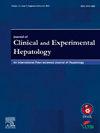初步实验室评分对肝细胞癌患者预后的影响:一项回顾性研究
IF 3.2
Q2 GASTROENTEROLOGY & HEPATOLOGY
Journal of Clinical and Experimental Hepatology
Pub Date : 2025-05-31
DOI:10.1016/j.jceh.2025.102604
引用次数: 0
摘要
背景/目的肝细胞癌(HCC)是一种预后多变的异质性肿瘤。我们的目的是评估不同的基于实验室的评分和指标来预测1年总生存期(OS)。方法188例HCC患者的临床资料。采用受试者工作特征(ROC)曲线、Cox回归分析和预测nomogram评估白蛋白-碱性磷酸酶比值(AAPR)、天冬氨酸转氨酶-淋巴细胞比值(ALR)、白蛋白-胆红素(ALBI)评分、中性粒细胞-淋巴细胞∗血小板比值(N/LPR)、中性粒细胞-淋巴细胞比值(NLR)、淋巴细胞-单核细胞比值(LMR)和血小板-淋巴细胞比值(PLR)与1年OS的关系。结果采用ROC曲线分析,AAPR、ALR、NLR、LMR、PLR预测1年OS的曲线下面积(AUC)分别为(0.704、0.697、0.743、0.677、0.693)。ALBI评分和N/LPR均不能显著预测1年OS,其中NLR的AUC最高。在经动脉化疗栓塞作为初始治疗的亚组中,NLR和PLR是准确预测1年OS的评分,auc分别为0.701和0.685。在多因素回归分析中,基线丙氨酸转氨酶升高、表现状态≥1、较大病变≥5、多发病变≥2、存在门静脉侵犯、存在淋巴结侵犯、NLR≤2.27、LMR≤3.40是1年死亡率的独立预测因素。多因素回归分析中包含独立预测因子的nomogram C-index预测1年死亡率为0.808(95%可信区间:0.771 ~ 0.845)。结论nlr和LMR是1年死亡率的独立预测因子,基于这两个评分的新型nomogram预测模型具有较高的预测效果。在预测1年OS方面,NLR优于其他基线无创血清评分。本文章由计算机程序翻译,如有差异,请以英文原文为准。

Prognostic Impact of Initial Laboratory-based Scores for Hepatocellular Carcinoma Patients: A Retrospective Study
Background/Aim
Hepatocellular carcinoma (HCC) is a heterogeneous tumor with variable prognosis. We aimed to evaluate different laboratory-based scores and indices to predict 1-year overall survival (OS).
Methods
A total of 188 patients with HCC were included. Albumin-to-alkaline phosphatase ratio (AAPR), aspartate aminotransferase-to-lymphocyte ratio (ALR), albumin-to-bilirubin (ALBI) score, neutrophil-to-lymphocyte∗platelet ratio (N/LPR), neutrophil-to-lymphocyte ratio (NLR), lymphocyte-to-monocyte ratio (LMR), and platelet-to-lymphocyte ratio (PLR) were evaluated in relation to 1-year OS using receiver operating characteristic (ROC) curves, Cox regression analysis, and a prediction nomogram.
Result
Using ROC curve analysis, area under the curve (AUC) values of AAPR, ALR, NLR, LMR, and PLR were (0.704, 0.697, 0.743, 0.677, and 0.693, respectively) for the prediction of 1-year OS. ALBI score and N/LPR failed to significantly predict 1-year OS, and the NLR has the highest AUC among all the scores. In the subgroup receiving trans-arterial chemoembolization as the initial treatment, NLR and PLR were the scores that accurately predicted 1-year OS with AUCs of 0.701 and 0.685, respectively. Baseline elevated alanine aminotransferase, a performance status ≥1, larger lesions ≥5, multiple lesions ≥2, the presence of portal vein invasion, the presence of lymph node invasion, an NLR >2.27, and an LMR ≤3.40 are independent predictors of 1-year mortality in multivariate regression analysis. The C-index of the nomogram, including independent predictors in the multivariate regression analysis, predicting 1-year mortality was 0.808 (95% confidence interval: 0.771-0.845).
Conclusion
NLR and LMR are independent predictors of 1-year mortality, and a novel nomogram prediction model based on these scores show a higher performance. NLR is superior to other baseline non-invasive serum-based scores for the prediction of 1-year OS.
求助全文
通过发布文献求助,成功后即可免费获取论文全文。
去求助
来源期刊

Journal of Clinical and Experimental Hepatology
GASTROENTEROLOGY & HEPATOLOGY-
CiteScore
4.90
自引率
16.70%
发文量
537
审稿时长
64 days
 求助内容:
求助内容: 应助结果提醒方式:
应助结果提醒方式:


